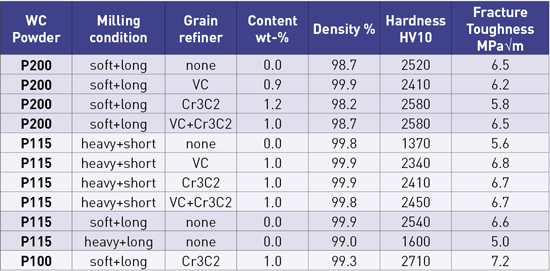Euro PM2012: Processing of Hardmetals
Sintering behaviour of Binderless Tungsten Carbide
Interesting sintering studies on the WC grain growth characteristics of binderless WC compacts with different grain growth inhibitors (GGI) such as Cr3C2 and VC, and WC grain sizes from 100 to 600 nm milled under different conditions were presented by Johannes Pötschke from the Fraunhofer Institute for Ceramics Technologies and Systems, Dresden.
The influence of the GGIs on sintering behaviour is evident from Fig. 1. Even though the start of sintering between 800 and 1400°C is not influenced by the GGIs, the authors data point out that GGIs shift the sintering temperature to higher temperature for full densification in the following order:
Without GGI<Cr3C2<Cr3C2+VC<VC

Fig. 1 Influence of added grain growth inhibitors on the sintering behaviour of the P115 starting powder (Courtesy EPMA)
The effect of milling conditions on the sintering rate is seen in Fig. 2. High intensity milling (not defined) reduces the final required sintering temperature by more than 150°C according to the authors. They correlate this with the change in surface area on milling, using the same starting WC powder.

Fig. 2 Influence of milling conditions on the sintering behaviour of the P115 starting powder (Courtesy EPMA)
In Table 1, the authors document the influence of WC grain size, milling conditions and GGI additions on the properties of binderless sintered WC compacts. Excellent mechanical properties with hardness up to 2600 HV10 and fracture toughness up to 6.5 Mpa√m were achieved.
In conclusion, it is pointed out that the correct choice of milling parameters to enhance sinterability could lead to binderless WC compacts with good mechanical properties, even without GGIs. Examples of the influence of milling on microstructure are presented in Fig. 3. In all cases pickup of cobalt by milling was in the 10’s of ppm range, i.e. almost negligible pickup.

Fig. 3 Microstructure development of WC P115 with different milling conditions, top: SE2-Images at 500x magnification – below: AsB-Images at 10000x magnification (Courtesy EPMA)
Interaction of Nitrogen with WC and Nitrogen-Assisted Sintering of Hardmetals
The influence of nitrogen on the properties and microstructure of TiCN Cermets and WC-Co Hardmetals with mixed carbides has been studied in depth by the Vienna University of Technology in the past decades. An interesting piece of work on the influence of nitrogen on WC grain size during sintering was presented by Prof. Dr. Walter Lengauer in his inimitable fashion.
Nitrogen was incorporated in tungsten carbide by two methods
a) During synthesis of WC powder by mixing tungsten and graphite powder in graphite boats with a heat treatment under a pressure of up to 40 Bar Nitrogen at temperatures up to 1600°C
b) By nitridation of commercial WC powders at 60 to 150 Bars in the temperature range 1100 – 1700°C for up to 5 hours.
Needless to say that during synthesis, the nitrogen content of the W(CN) powders is dependent upon pressure as has also been published by Japanese researchers. In this work, more than 10% nitrogen could be incorporated in WC, whereas the nitrogen partially replaced the carbon atoms in the tungsten lattice to yield stoichiometric ratios very close to 1 for the (C+N)/W ratio.
As can be seen in Table 2, the replacement of carbon by nitrogen leads to a decrease in the both the lattice parameters a and c of the hexagonal unit cell of WC.

Table 2 Nitrogen content and lattice parameters (together with standard deviation δ) of WC synthesised under nitrogen atmosphere (Courtesy EPMA)
The nitridation experiments clearly brought out the fact that the diffusivity of nitrogen in WC is very low. In this case only surface nitridation could be detected and this was more for finer WC grains compared to coarser WC grains. The authors go on to demonstrate that nitrogen reduces grain growth, especially below temperatures of 1400°C in the case of the powders studied here.
The second part of this paper presents results on sintering of these two types of nitride powders with 10Wt% cobalt and grain growth inhibitors. The synthesized WCN powders show outgassing of nitrogen in three or four steps in accordance with the different types of bonding of N in the WCN crystals. The earliest outgassing temperature is around 1187°C at which temperature a two phase liquid equilibria (confirmed by DTA results) exists.
The results presented could lead to the conclusion that WCN powders need to be consolidated under different pressing parameters and that degassing leads to large pores at high nitrogen contents. The authors also note that WC grain refinement could be observed at a nitrogen content of 0.02%, without any porosity if sintered under Nitrogen. This confirms results from the dawn of Hardmetals technology that the sinterability of WC-Co mixtures is dependent on the atmosphere. Whereas hydrogen is followed by vacuum in terms of densification rate, nitrogen and argon atmospheres show lower sinterability and lower grain growth of WC.

Fig. 4 Right: Microstructure of hardmetals with original WC and nitrided WC (WC/10%Co). Top: original WC, middle: WC nitrided at 1700°, bottom: WC nitrided at 1100°C. Left: corresponding linear intercept evaluation of WC grain size (from 3 images). The data given in the graphs are average values by vacuum and SinterHIP cycles. All hardmetal formulations contained conventional grain-growth inhibitors VC + Cr3C2. SEM/BSE 25,000x (Courtesy EPMA)
The data presented by the authors in Fig. 4 is interpreted that low temperature nitriding of WC , i.e. below 1300°C leads to decreased grain growth of WC in the WC-Co alloys by the inhibition of solid state grain growth of WC particles, probably at temperatures below 1130°C. The authors suggest that nitriding WC powder with a nitride rim is beneficial for retarding WC grain growth.
Author: Dr. Leo J Prakash holds a Ph.D. in Cemented Carbides and has over three decades of experience in the field of cutting tools for wood and metals as well as wear parts. Email: [email protected]
News | Articles | Market reviews | Search directory | Subscribe to e-newsletter






